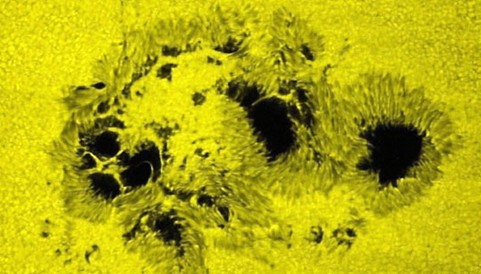发布时间: 2016年12月09日

『全球变暖是人类必须面对的问题,许多国家纷纷推行节能减排的相关措施。而好消息是,最近的研究数据显示,太阳将要进入一段“平静期”』
Sun down
落山的太阳
June 16th 2011 | from The Economist

DURING the four centuries that it has been studied in detail, the sun has usually behaved in a regular manner. The number of spots on its surface has waxed and waned in cycles that last, on average, 11 years. Such cycles begin with spots appearing in mid-solar latitudes and end with them near the equator. And the more spots there are, the more solar storms there are around.
An absence of sunspots also means an absence of solar flares and their more violent siblings, coronal mass ejections. Such outbursts disrupt radio and satellite communications, electricity
grids and a variety of electronic equipment, so the pattern of solar activity is of more than academic interest. A new solar minimum, then, would test theories about how the climate works and also make communications more reliable. And many solar physicists think such a new minimum is on the cards. Frank Hill and his team were the discoverers, 15 years ago, of an east-west jet stream in the sun. They also worked out that the latitude of this wind is related to the sunspot cycle. At the beginning of a cycle the jet stream is found, like sunspots, in mid-latitudes. As the cycle progresses, it follows the spots towards the equator.
Intriguingly, however, Dr Hill’s studies indicate that the jet stream of a new cycle starts to form years before the sunspot pattern. This time, that has not happened. History suggests a new cycle should begin in 2019. If the sun were behaving itself, Dr Hill’s team would have seen signs of a new jet stream in 2008 or 2009. They did not. Nor are there indications of one even now. If a change in the jet stream really is a leading indicator of solar activity, then no new cycle is on the horizon.
The second study which suggests something odd is happening looked at the strengths of sunspots. Matthew Penn and William Livingston have analysed 13 years of data which indicate that, independently of the number of spots around, there has been a decrease in their strength.
Sunspots are caused by irruptions into its surface of the sun’s deeper magnetism. These create local drops in temperature, which make the surface gas darker. Over the period which Dr Penn and Dr Livingston analysed, the average magnetic strength of the irruptions has declined. Below a certain threshold, they will not be strong enough to overcome the convective mixing of the gas at the surface, and spots will disappear altogether. If the present trend continues, that will happen in 2021.
The third measure of the sun’s decline is in its outer atmosphere, the corona. At each solar maximum, the corona sloughs off the magnetic fingerprint of the previous cycle by pushing it to the poles. According to Richard Altrock, the leader of another NSO team at the meeting, that does not appear to be happening in the present cycle. It looks, then, as if a new, extended solar minimum is about to begin.
That is good news for operators of communications satellites. And it is interesting news for those who worry about global warming. If the Maunder and Dalton minima actually did affect the climate, then a new one might counteract the effects of the extra greenhouse gases people are now pumping into the atmosphere—at least, until the solar cycle returns. Whether the breathing space thus granted would be used wisely or squandered is another matter. Do not expect that debate to be as placid as the spotless sun.
1 coronal /5kɔ:rənəl/ adj. 冠状的;日冕的
2 equator /i5kweitə/ n. 赤道
3outburst /5autbə:st/ v. (火山、情感等的)爆发;破裂。
4 sibling /5sibliŋ/ n. 兄弟姊妹;民族成员
5 sunspot /5sʌnspɔt/ n. 太阳黑子;雀斑
6 wane /wein/ v. 衰落;变小;
7 wax /wæks/ v. 月亮渐满;增大
8 convective /kən5vektiv/ adj. 对流的;传递性的
9 corona /kə5rəunə/ n. 电晕;日冕;冠状物
10 electronic /9ilek5trɔnik/ adj. 电子的
11 grid /ɡrid/ n. 网格;格子,栅格;输电网
12 intriguingly /in5tri:giŋli/ adv. 有趣地;有魅力地
13 irruption /i5rʌpʃən/ n. 闯入,侵入;激剧繁殖
14 jet stream: 急流,射流;喷射气流
15 magnetism /5mæɡnitizəm/ n. 磁性,磁力;磁学;吸引力
16 maximum /5mæksiməm/ n. 极大,最大限度;最大量
17 mid-latitude: n. 等比例纬线;中分纬度
18 minimum /5miniməm/ n. 最小值;最低限度;最小化
19 on the cards: 可能
20 on the horizon:在地平线上;即将来临的
21 counteract /9kauntə5rækt/ v. 抵消;中和;阻碍
22 pump /pʌmp/ v. 抽水
23 solar cycle:太阳(活动)周期
24 squander /5skwɔndə/ v. 浪费
上一篇: 提升考研复习效率的三大定律
下一篇: 英语典故:Adam's Apple喉结
历年考研真题下载